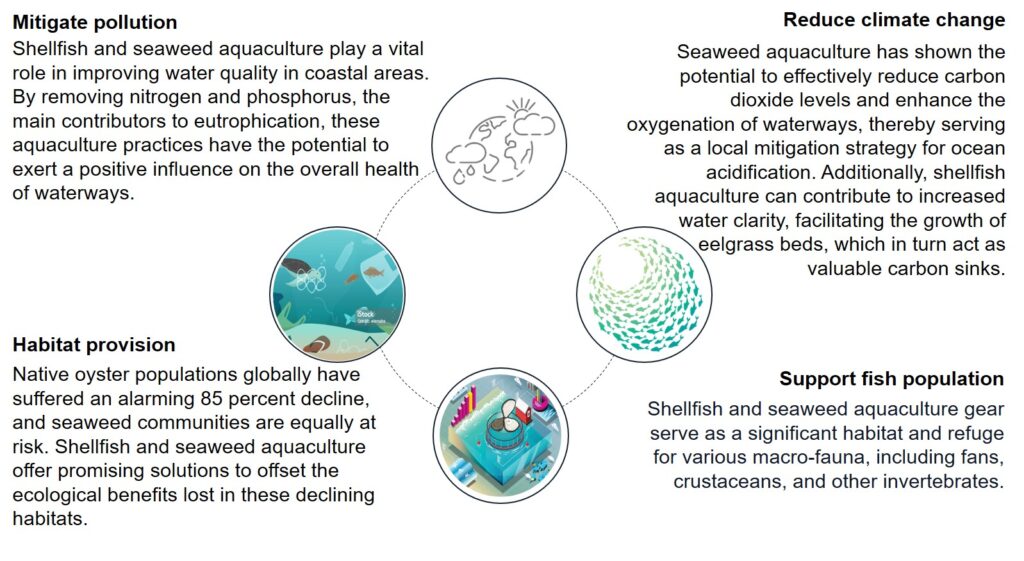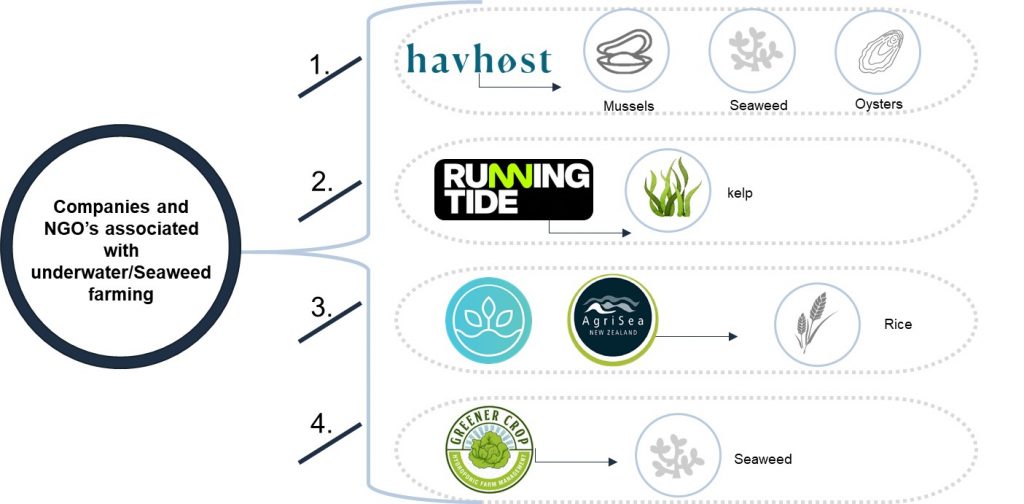It is nearly hard to combat the reality that the world’s population requires more food to survive, and worries have been expressed about how farming practices are harming the ecosystem; for example, deforestation is a huge issue, with agriculture being the primary cause of the countless acres of destroyed forest. Additionally, the amount of available arable land is shrinking, and when you consider that raising animals requires a significant quantity of land, this is even more concerning. The ocean farming is emerging as the silver lining in the discovery of sustainable food.

Industrialized farming was initially thought to be the answer to the world’s rapidly expanding population, but it harms the environment.
By leveraging the untapped potential of just 2% of the world’s seas for underwater farming, we could address the pressing issue of global food security while simultaneously promoting sustainability. Underwater farming offers a remarkable solution, as it has the ability to flourish without the need for pesticides.
Need For Underwater Farming
- An overreliance on pesticides, wildlife eviction, water waste, and the production of toxic gases is harming our planet
- Animal production is the major contributor to greenhouse gas emissions. 15% of the pollution in our atmosphere is caused by animal production
- Feeding 100% of the population in the world is impossible for the agriculture sector, and the food system will collapse if we continue to rely on “conventional” agricultural production. Instead, we can use some of the 97% available water to grow food underwater. The way we generate food thus has to change.
Type of Ocean Farming
Ocean farming, like field farming, has different aspects of agriculture and can be performed on different ocean sites. It can be on the coast, seashore, or offshore. Also, there are different types of ocean farming, as it can be performed on the floating platform of the ocean, deep inside the ocean, or somewhere in the middle.
1. Underwater Crop Farming:
Nemo’s Garden has developed the first underwater farming project, which benefits the environment by eliminating the need for pesticides as no pests can enter the pods unless they are introduced additionally, and by conserving water as seawater in the pods evaporates and then condenses back down to provide the plants with fresh water.
This project includes:
- Six air-filled plastic pods anchored at the pits of the sea off the coast of Noli in Italy
- The plastic pods suspend at different depths and have sensors to measure carbon dioxide levels, oxygen levels, humidity, air temperature, and illuminations
- Each dome has seedbeds and a 10-meter spiral tube connecting to the tanks that hold irrigation water and fertilizers. A pump delivers the water and fertilizers to the plants
- A water control tower, fitted with solar panels, controls a fan in each biosphere to reduce plant humidity while managing these functions
2. Vertical Farming/Polyculture Farming/Regenerative Ocean Farming:
GreenWave, a North America-based organization, has developed an agricultural technique called vertical underwater farming or regenerative ocean farming with a sustainable approach.
The project benefits the sea environment with a high range of seaweed like kelp and shellfish, which grow on a rope scaffolding system under the sea. It requires zero inputs such as water, fertilizer, or feed while also rebuilding marine ecosystems. The seaweed absorbs CO2 from the ocean, making the water less acidic and helping wildlife thrive. In contrast, bivalves such as oysters improve water quality.
With this kind of polyculture farming, GreenWave can provide high yields, a small carbon footprint, and a low barrier to entry, as anyone with 20 acres, a boat, and $20,000 to $25,000 can start their farm.
3. Pre-Owned Shipping Container Farms:
With a series of patents, the University of Nottingham has developed the concept of floating deep farms that consist of large vertical shafts or containers submerged under seawater near coastal areas.
These containers are sealed at the bottom and connected with a dome at the top. A hydroponic or Aeroponic system, connected to LED lights for seawater desalination, grows the crops, providing a suitable environment for the plants to thrive.
Floating deep farms have the potential to contribute to sustainable food production by reducing reliance on traditional land-based farming methods, conserving land resources, and minimizing the environmental impact associated with agriculture. However, it is worth noting that their development and widespread adoption are still in the early stages, and we must address several challenges.
4. Rice In The Ocean:
Working on the ancient finding of seagrasses that migrated back into the saltwater ocean around 75 million years ago, scientists at Alora have developed a CRISPR tools-based technique that activates the set of genes in terrestrial crops such as rice.
To someday cultivate rice on floating platforms off the beaches of African and Asian nations, they are launching an effort to grow rice plants on land in salty waters.
Controlled Carbon Emission
Atmospheric carbon dioxide contaminates the ocean ecosystem, profoundly impacting aquatic life there. Some research suggests that growing seaweed could be a “compelling” way to remove carbon dioxide from the water. Cultivated seaweed might find use in bioenergy systems or as a substitute for more greenhouse gas-intensive foods like animal-based diets to reduce emissions.
Seaweed, such as kelp and macro-algae, uptakes carbon dioxide for growth and cleans the environment. By enhancing soil quality, replacing synthetic fertilizers, and lowering methane emissions from cattle when included in the feed, seaweed aquaculture can also help reduce emissions from agriculture.
One of the challenges with seaweed cultivation is that it is complex, costly, and time-consuming. With all the abovementioned challenges, controlling climate and ocean currents is also tricky for seaweed farmers.
Sea Monitoring System
Sealens provides high-tech solutions for monitoring underwater quality for seaweed growth and management, as it is associated with a programmable high-resolution underwater video & photo camera for monitoring long-term changes to the environment, a high-resolution data logger that measures light intensity, flow (current speed) and temperature underwater for long periods and water quality monitoring system which monitors pH, salinity, dissolved oxygen, and temperature over long periods.
Underwater Drones:
A robotic system for underwater monitoring and sampling seaweed provides digital water future quality measurement and visual data collection. It also identifies the algae farm’s exact position and offers advanced capabilities for efficient and accurate underwater farming operations.
Ice-Ice syndrome:
Ice-ice syndrome is a massive fragmentation and degradation of seaweed quality caused by the whitening/discoloration of the old thallus. The rise in coastal eutrophication and increasing climate change-related events has caused a surge in the risk of diseases.
Biosecurity protocols can minimize the onset of diseases by continuously implementing written basis biosecurity measures. These measures include using healthy, uninfected propagules and regularly cleaning the seaweed thallus and farm ropes to remove biofouling. Early identification of infected stock is also a key part of the protocol. Additionally, the use of bleaching powder or potassium permanganate applied to water supplies in seedling nurseries can prevent the growth of the main pathogenic microorganisms. Such comprehensive biosecurity practices play a crucial role in safeguarding the health and productivity of oceanic farming operations.
Challenges With Ocean Farming
Ocean farming, with a bright potential for future farming systems, faces infrastructure and production unit challenges. Unsettling ocean currents can disrupt the farming arrangement, lead to species loss, and increase production costs. However, addressing these challenges is crucial to unlocking the full benefits of ocean farming for sustainable food production and environmental conservation.
Ocean farming, if not handled properly, can also be a threat to the environment. There is insufficient protection of coastal ecosystems, and the introduction of alien species by seaweeds can disrupt local environmental conditions. Additionally, cleaning, preparation, and breakage of artificial crop-holding mesh can contribute to ocean pollution. Routine management of culture sites may lead to the potential loss of species and habitat diversity. Additionally, the attenuation of water movement can cause eutrophication, further highlighting the importance of responsible practices in ocean farming. Besides challenges in ocean-related facilities, it is still tricky to handle underwater farming. Accessing international markets and working with AI and automated systems with weak signals in the ocean regions is challenging.
List of Companies and Organizations Working in Ocean Farming

Figure 2: Companies and organizations involved in ocean farming
Conclusion
The world is witnessing several innovations in the agriculture sector, including zero-budget natural farming and underwater Agriculture. Underwater farming can overcome the growing demand for food and disturbances caused by rapid climate change. In addition to combating the consequences of climate change, ocean crop farming could also address the looming problems of water scarcity and inadequate nutrition. Companies are taking steps to launch full-scale production units for underwater farming to meet consumer demand. They believe using resources and opportunities from plant and fish production offers a unique approach to achieving more sustainable agriculture. Moreover, this approach allows for a holistic utilization of marine ecosystems to address food security and environmental challenges. Also, more creative methods of reducing climate change are required as it remains one of the most pressing global challenges.